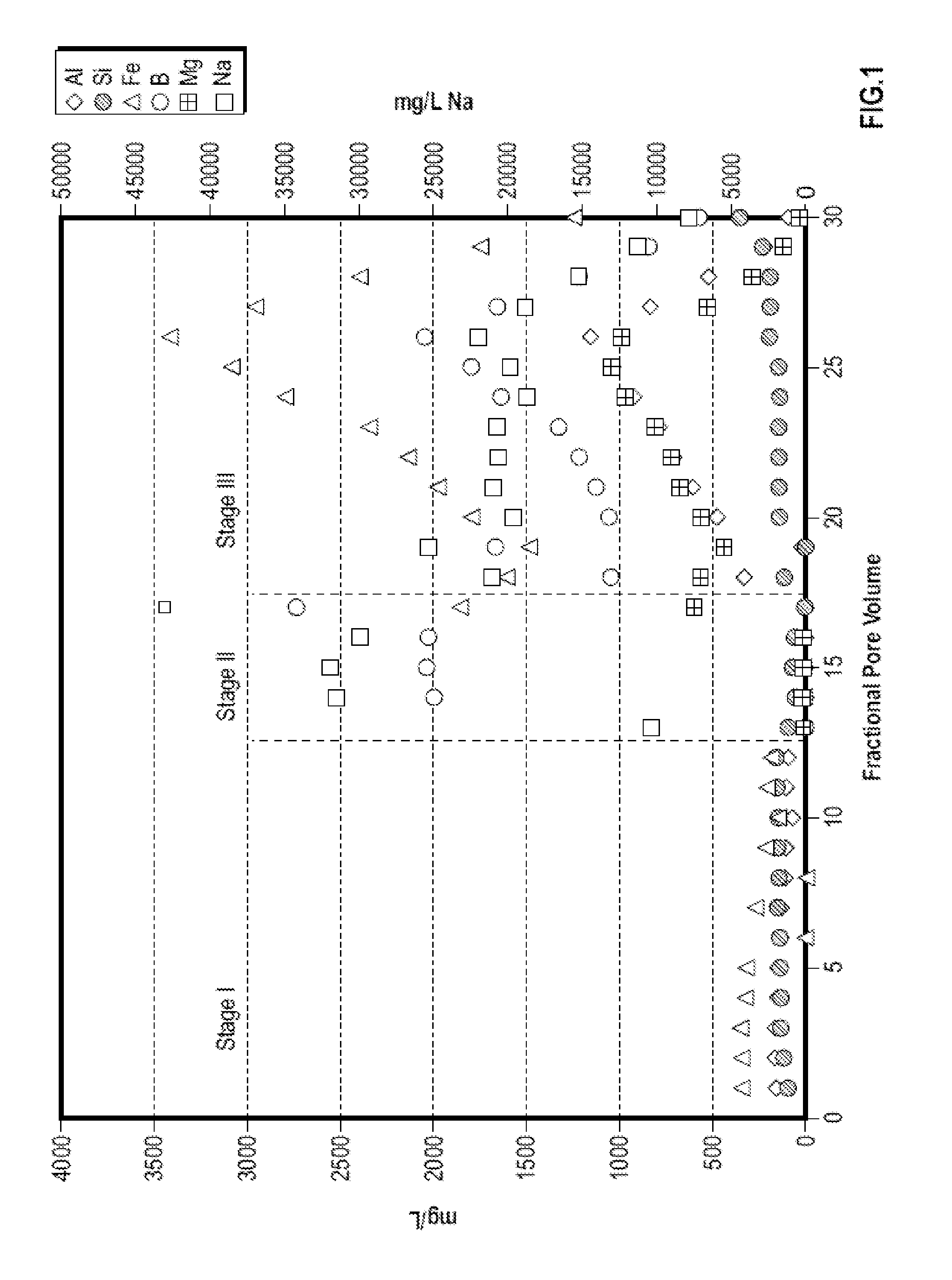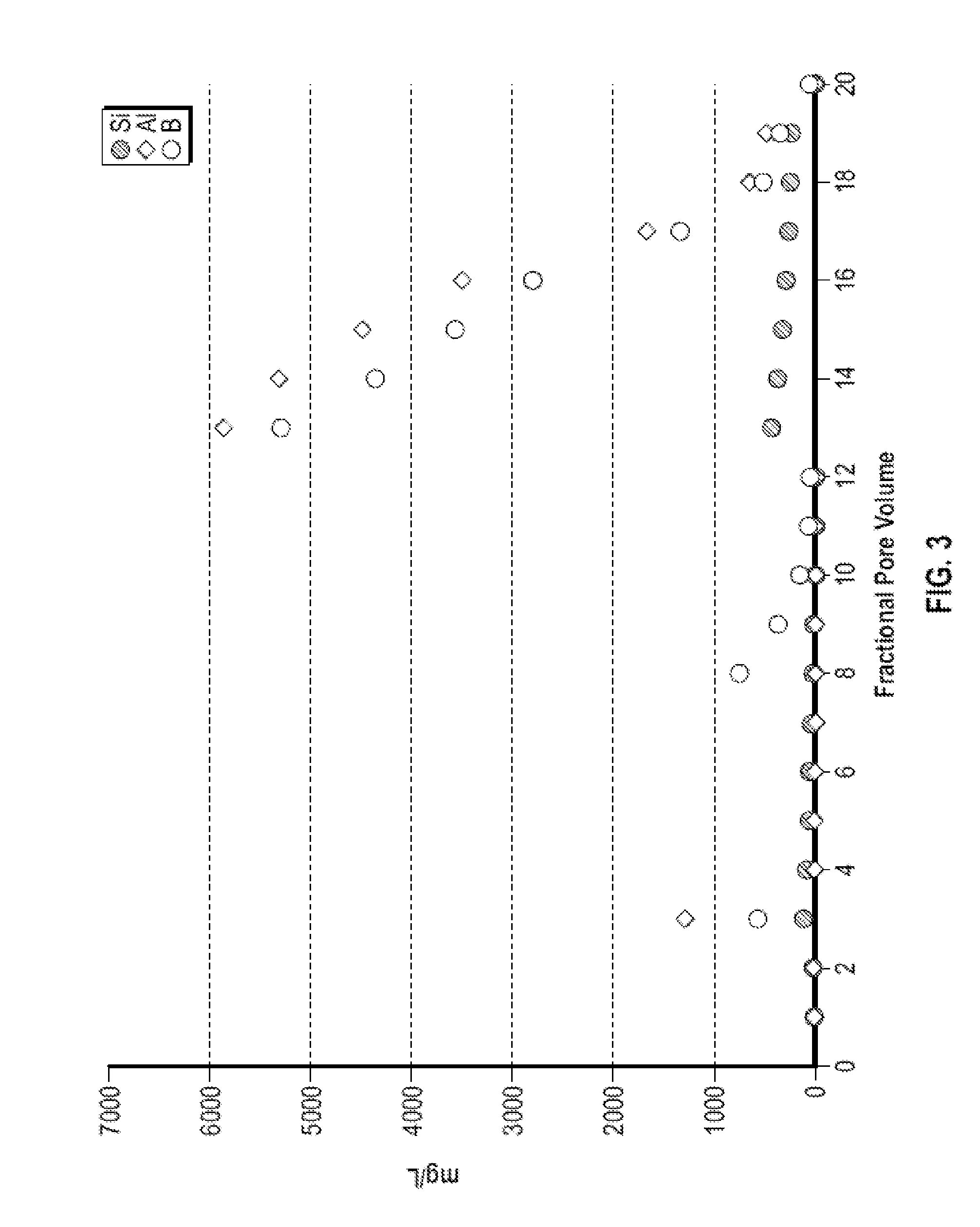Treatment fluids containing a boron trifluoride complex and methods for use thereof
a technology of boron trifluoride complex and treatment fluid, which is applied in the field of treatment fluids, can solve the problems of less or no effect of siliceous formation treatment with these acids, increased formation of boron trifluoride,
- Summary
- Abstract
- Description
- Claims
- Application Information
AI Technical Summary
Benefits of technology
Problems solved by technology
Method used
Image
Examples
example 1
[0070]The synthetic pack employed was a quartz and chlorite (CCa-1, Ripidolite, Flagstaff Hill, Calif.) mixture in a 95:5 ratio that was equilibrated for 16-24 hours in 2% NaCl brine and maintained at 245° F. The treatment fluid contained 5% TRILON® M (sodium salt of methylglycine diacetic acid, available from BASF) and 0.17% boron trifluoride dihydrate complex at pH 3.68. A preflush treatment fluid of 15% v / v TRILON® M at pH 4 was also used (see below). Any necessary pH adjustments were made with 36% HCl or a sufficient quantity of TRILON® M stock solution (pH 11). Several pore volumes of a like treatment fluid lacking the boron trifluoride complex were flowed through the core pack before introducing the treatment fluid containing the boron trifluoride complex.
[0071]FIG. 1 shows an illustrative plot of the concentration of various ions in fractional volumes collected from a flow test of a synthetic core pack of quartz and chlorite at 245° F. using a treatment fluid containing 0.17%...
example 2
[0072]This example was performed similarly to Example 1, except the synthetic core pack was a 10% kaolinite / 90% quartz mixture equilibrated at 240° F., and the treatment fluid contained 5% Trilon® M and 0.4% boron trifluoride dihydrate complex at a pH of 3.8.
[0073]FIG. 2 shows an illustrative plot of the concentration of silicon, aluminum, and boron in fractional volumes collected from a flow test of a synthetic core pack containing 10% Kaolinite and 90% quartz (55% SSA-1 and 45% 20 / 40 Brady Sand) at 240° F. using a treatment fluid containing 0,4% boron trifluoride dihydrate complex and 5% TRILON® M at pH 3.8, The first 10 fractions after equilibration (stage II) were collected at a flow rate of 1 mL / min. Thereafter, a 12-16 hour shut-in period was mimicked by stopping flow. Following the shut-in period, the remaining samples were collected at a flow rate of 1 mL / min.
[0074]The ionic profile of the effluent displayed a progressive appearance of aluminum as the packed column was broug...
example 3
[0075]This example was performed with a synthetic core pack of 15% kaolinite / 85% quartz mixture equilibrated at 245° F. The treatment fluid contained 15% Trilon® M and 0.4% boron trifluoride dihydrate complex at a pH of 3.45. A treatment fluid containing 20% v / v TRILON® M at pH 2 and lacking a boron trifluoride complex was first flushed through the core pack (3 pore volumes), followed by a 1 hour shut-in period. After the shut-in period, the packed column was flushed with 0.2 M NaCl, returning the pH of the effluent to 6.6. Thereafter, the treatment fluid containing the boron trifluoride complex (150 mL) was introduced, followed by a shut-in period of 180 minutes. Following the second shut-in period, the core pack was eluted with 0.2 M NaCl solution.
[0076]FIG. 3 shows an illustrative plot of the concentration of silicon, aluminum, and boron in fractional volumes collected from a flow test of a synthetic core pack containing 15% Kaolinite and 85% quartz (55% SSA-1 and 45% 20 / 40 Brady...
PUM
| Property | Measurement | Unit |
|---|---|---|
| temperature | aaaaa | aaaaa |
| temperatures | aaaaa | aaaaa |
| pressure | aaaaa | aaaaa |
Abstract
Description
Claims
Application Information
 Login to View More
Login to View More - R&D
- Intellectual Property
- Life Sciences
- Materials
- Tech Scout
- Unparalleled Data Quality
- Higher Quality Content
- 60% Fewer Hallucinations
Browse by: Latest US Patents, China's latest patents, Technical Efficacy Thesaurus, Application Domain, Technology Topic, Popular Technical Reports.
© 2025 PatSnap. All rights reserved.Legal|Privacy policy|Modern Slavery Act Transparency Statement|Sitemap|About US| Contact US: help@patsnap.com



